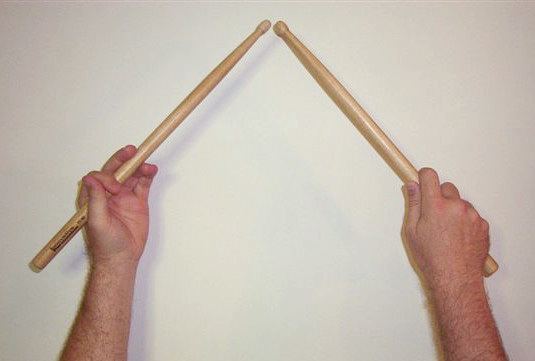 | ||
Traditional grip (also known as orthodox grip) is a technique used to hold drum sticks while playing percussion instruments. Unlike matched grip, each hand holds the stick differently. Commonly, the right hand uses an overhand grip and the left hand uses an underhand grip. Traditional grip is almost exclusively used to play the snare drum, especially the marching snare drum, and often the drum kit. Traditional grip is more popular in jazz drumming than in other drum kit styles due to the early jazz drummers evolving their style from marching and military styles and instrumentation, although it is also used by several rock drummers.
This grip is called traditional because it descends from military marching drummers who carried a snare drum on a sling hung from the neck or one shoulder, with the drum riding closer to one hip than the other and tilted slightly for easier reach. This allowed the drummer to play the drum and march without banging his knees or thighs into the drum. Because of that drum position, using an overhand grip on the high (left) side of the drum would force the elbow into a very awkward position while an underhand grip is much more comfortable. Even when the drum is on a stand, many drummers will tilt their drum when using traditional grip, although tilting is not required. Many drummers use traditional grip on drums that are perfectly horizontal, especially in marching percussion.
With the underhand grip, there are several different techniques employed which involve slight variations in finger positioning and usage. Common with all techniques is the usage of the wrist in rotating (a motion like turning a door knob) as the fundamental motion of the stick. Once the stick has started moving, more involved techniques require the exclusive use of the thumb for bouncing the stick when playing at a faster tempo. The stick then rests in the space between the thumb and index finger, and the two fingers close around the stick with the thumb atop the index at the first knuckle. The middle finger then rests slightly on top side of the stick (typically the side fingertip is the only contact made). The stick then rests on the cuticle of the ring finger with the little finger supporting the ring finger from below.
Sanford A. Moeller (whose book discusses the Moeller method or Moeller technique) suggests that one should learn the traditional grip 'ancient style', as well ... where the overhand grip should hold or grip the drumstick almost entirely with the little finger.
Criticism
Some percussionists reject traditional grip, as it is believed to be inferior to matched grip in terms of convenience, efficiency, and quality of sound. Unlike German, French and American matched grip, the traditional grip is rarely used with the majority of other percussion instruments (e.g., mallet percussion or timpani).
Despite these criticisms, traditional grip has been used, and in some cases continues to be used by some of the best percussionists of modern times. Notwithstanding most of the criticisms, traditional grip is used by Division I drum corps to play the marching snare drum, due to its aesthetic appeal. Those doing military re-enactments also use this grip (e.g. American Civil War, American Revolution, etc.).
